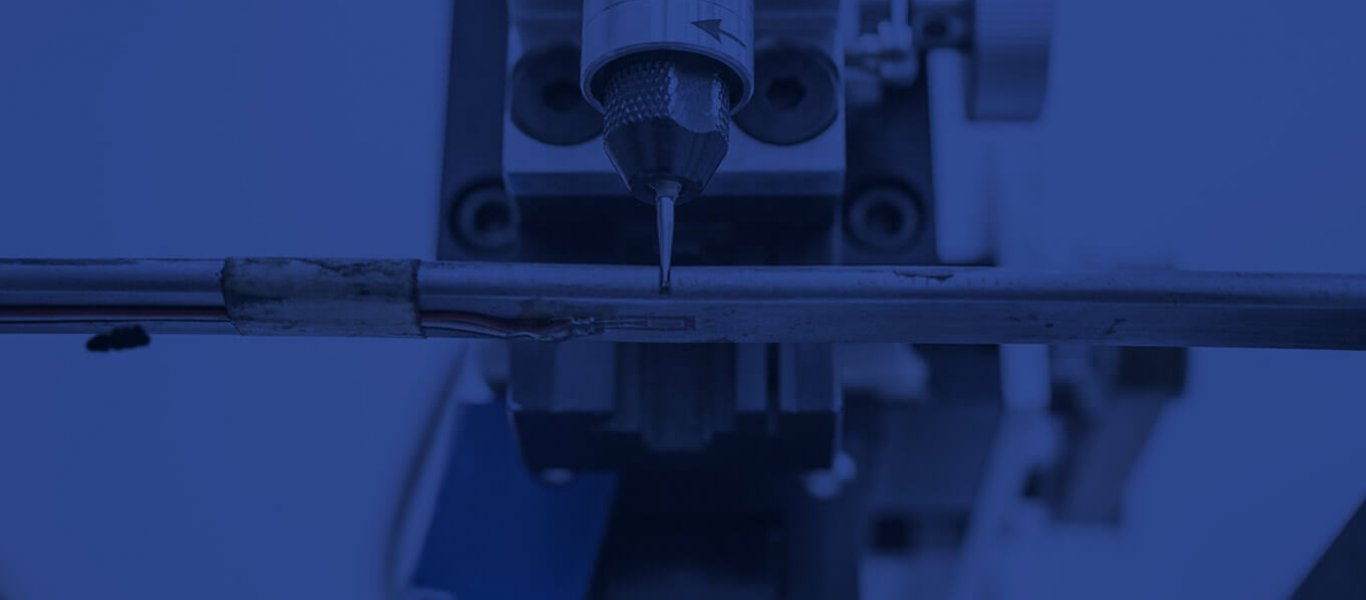Slitting Technique
The Slitting or Crack Compliance technique is a destructive, mechanical strain release (MSR) technique that can accurately measure both near surface and through thickness residual stresses.
The technique involves cutting a slit across a component, typically using wire-EDM, and measuring the surface strains with strain gauges located underneath or next to the slit. During the procedure the slit depth is increased incrementally to predetermined depths and the strain at each depth increment is recorded. The surface strain relaxations are related to the stresses throughout the specimen thickness using numerically determined influence coefficients. Typically the underneath (or back) strain gauge is most important and is used for the calculation of through thickness residual stresses, however the top strain gauge also gives further information about the top surface stresses during the first few EDM increments.

Schematic of the Slitting technique.
Analysis of the strain data from the Slitting process is carried out using elastic inverse solutions. The most commonly seen analysis is the polynomial series expansion method which is performed by assuming a polynomial expansion for the unknown residual stress profile and finding the ‘compliance coefficients’ that relate the stress at each slit depth to the given strain relaxation [2]. Another common method for the analysis is the ‘integral’ or ‘pulse’ method which is a more popular solution for rapidly changing stress fields where applying a least squares fit to the strain data is not considered accurate.
The Slitting technique is good for measuring uniaxial residual stress profiles in specimens with prismatic cross sections, where the stress profile only varies in one direction (i.e. in the direction of incremental cutting), and moment and stress distributions across the measurement section are balanced.
Procedure of the Slitting Technique:
The basic experimental procedure is as follows:
- Prepare (e.g. smooth and degrease) the component surface at the strain gauge locations.
- Glue the uniaxial strain gauges to the front and back of the specimen and attach the lead wires.
- Waterproof/encapsulate the strain gauges to ensure they are not damaged by the EDM fluid or agitated by fluid flow (not necessary for mechanical cutting).
- Align and fix the specimen relative to the EDM wire or mechanical cutter so that the back strain gauge is directly underneath the cut.
- Perform a series of slitting increments up to 90% of the specimen thickness and record the strain gauge readings after each increment.
- After the experiment is complete make further measurements to check slit depth, thickness and alignment to strain gauge, and make adjustments to the analysis procedure where appropriate.
- Analyse the strain gauge data to calculate the residual stress distribution.

Advantages of the Slitting Technique:
- Depth of measurement only limited by the size of slitting machine used, >100mm depth is possible;
- Very good for measuring residual stress gradients;
- Applicable to a wide range of materials, both metallic and non metallic;
- Nominal accuracy: 10MPa – Aluminium, 30MPa – Steel, 15MPa – Titanium;
- Indifferent to grain structure/texture of component material;
- ‘Clean’ EDM surface allows further research such as etching, x-ray and even contour measurements;
- Relatively quick and easy to apply the process;
- Very price competitive with respect to the depth of measurements made;
- Front and back strain gauges allow for the cross comparison of results and added information about residual stresses at the surface.

Example results for a 50mm thick 4-point plastically bent beam.
Disadvantages of the Slitting Technique:
- Destructive;
- Laboratory based measurements;
- Uni-axial residual stress measurements;
- Increased uncertainty in surface residual stress measurements;
- Increased uncertainty in the measurement of high magnitude residual stresses;
- Difficult to apply to complex shaped components and stress fields;
- Strain gauges used are susceptible to noise and require surface preparation and coating;
- Reliant on good strain response curves, or strain response is ‘smoothed’ with least squares fit.
References & Further Reading:
- M. B. Prime, “Experimental Procedure for Crack Compliance (Slitting) Measurements of Residual Stress”, LA-UR-03-8629, Los Alamos National Laborotary Report, 2003.
- Prime, M. B., and Hill, M. R., "Uncertainty, Model Error, and Order Selection for Series-Expanded, Residual-Stress Inverse Solutions", Journal of Engineering Materials and Technology,128(2), pp. 175-185, 2006.
- Prime, M. B., 1999, “Residual Stress Measurement by Successive Extension of a Slot: The Crack Compliance Method,” Appl. Mech. Rev., 52(2), pp. 75-96.
A good source of literature for further reading can be found at www.lanl.gov/residual/refs.shtml published by Dr. Mike Prime, a leading expert in this field along with Prof. Mike Hill who has a webpage at http://mae.ucdavis.edu/~mhill/


